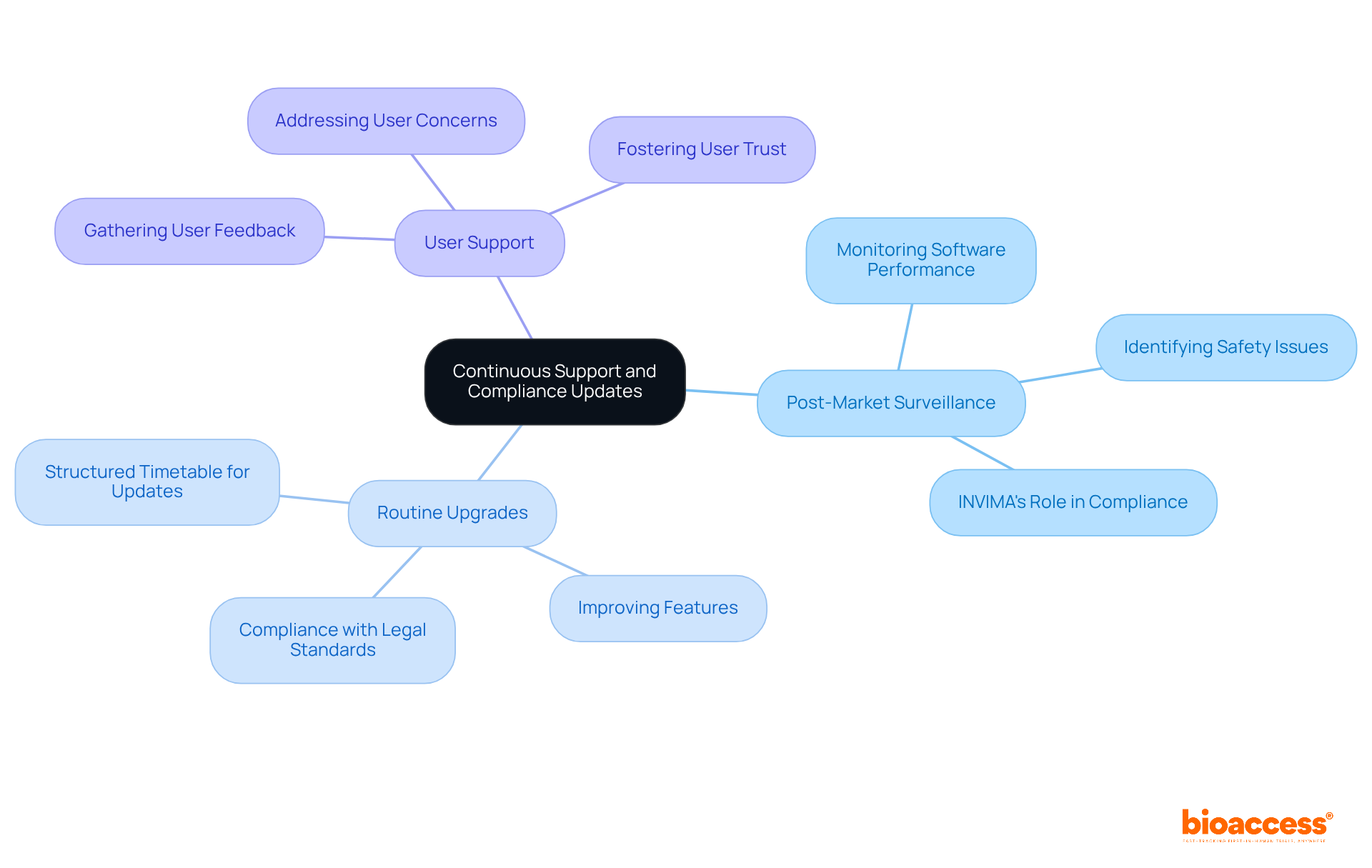


Mastering software development for medical devices is crucial, encompassing key practices such as:
These practices are essential for aligning software with safety standards and regulatory requirements. Notably, companies that have adopted proactive compliance and rigorous testing protocols have successfully reduced time to market and minimized post-market issues. This underscores the importance of integrating these practices to enhance product reliability and safety.
Navigating the intricate landscape of software development for medical devices presents a unique set of challenges and opportunities. As regulations tighten and technology evolves, developers must master key practices that not only ensure compliance but also enhance product safety and efficacy. This article delves into essential strategies, from understanding regulatory frameworks to implementing robust testing protocols, all aimed at fostering innovation while adhering to stringent standards.
How can developers effectively balance agility and compliance in this rapidly changing environment? What best practices can lead to successful outcomes in medical device software development?
Understanding the legal frameworks governing software development for medical devices is crucial for ensuring compliance and product safety. Key regulations, such as the FDA's guidelines for software development for medical devices and the ISO 13485 standard that delineates quality management systems, play a vital role in this process. Developers who are well-versed in these regulations can effectively align their software development for medical devices with established safety and efficacy standards. Moreover, staying abreast of updates—like the FDA's recent guidance on artificial intelligence in medical devices—is essential for maintaining compliance. Engaging with oversight organizations early in the development process can facilitate smoother approvals and expedite market entry.
A notable example is a healthcare technology firm that successfully integrated compliance into its application development process. By proactively addressing regulatory requirements during the design phase of software development for medical devices, the company achieved a remarkable 30% reduction in time to market. This case exemplifies the tangible benefits of a strategic approach to regulatory integration, underscoring the importance of compliance in the rapidly evolving Medtech landscape.

Applying best practices in the software creation lifecycle (SDLC) is essential for high-quality software development for medical devices. Two primary methodologies are Agile and Waterfall. Agile promotes iterative development and rapid feedback, making it ideal for projects that require flexibility and adaptability. In contrast, Waterfall provides a structured method, advantageous for projects with clearly defined requirements and compliance limitations. The selection of methodology should correspond with the project's complexity and specific compliance requirements.
Key best practices include:
A notable example of successful implementation is a company that adopted Agile practices within its SDLC, resulting in a remarkable 40% increase in team productivity and a significant reduction in bugs during the testing phase. This demonstrates the concrete advantages of incorporating Agile methodologies into the software development for medical devices. Moreover, with 70% of projects facing setbacks in medical technology creation, Agile methodologies assist in handling these delays by encouraging iterative progress and ongoing feedback, which improve product quality and shorten the time to market. Furthermore, the 81% rise in unplanned requirements churn in medical product creation emphasizes the adaptability of Agile in handling such changes.

Prioritizing testing and validation is crucial in software development for medical devices applications. This process not only confirms that the application meets its specifications but also validates that it fulfills its intended use. Key testing strategies include:
In the context of software development for medical devices, validation must also align with compliance standards, such as the FDA's General Principles of Software Validation, ISO 14971 for risk management, and IEC 62304 for lifecycle processes, which emphasize the importance of thorough documentation and adherence. Implementing a risk-based approach to testing allows teams to focus on the most critical aspects of the software, enhancing safety and efficacy. This approach aligns with regulatory frameworks by ensuring that high-risk areas receive the most attention during testing.
For example, a medical equipment company that implemented a comprehensive validation strategy reported a 50% decrease in post-market issues, highlighting the effectiveness of rigorous testing protocols. This statistic underscores the considerable influence that a well-organized testing procedure can exert on the overall success and dependability of medical instruments. Additionally, incorporating a Validation Master Plan (VMP) can further strengthen testing efforts and is often requested during audits, ensuring that all aspects of validation are systematically addressed.

Providing ongoing assistance and adherence updates is crucial for the long-term success of medical equipment applications. This involves several key practices:
A robust post-market surveillance system can help identify potential safety issues early, facilitating timely interventions. For example, a company that effectively executed a continuous compliance strategy was able to quickly adjust to legal changes, thereby preserving its market position and ensuring user trust. This proactive approach not only enhances product safety but also reinforces the company's reputation in a competitive landscape, particularly in regions like Latin America where regulatory excellence is paramount.

Mastering software development for medical devices necessitates a thorough understanding of regulatory frameworks, best practices in the software development lifecycle, rigorous testing and validation, and ongoing support and compliance updates. By integrating these elements, developers can ensure their products not only meet safety and efficacy standards but also achieve faster market entry and greater user satisfaction.
This article underscores the critical importance of familiarizing oneself with regulations such as the FDA guidelines and ISO standards, which are pivotal for compliance. It examines how adopting methodologies like Agile can enhance productivity, while comprehensive testing strategies guarantee that software performs as intended and meets user needs. Moreover, continuous monitoring and updates post-launch are essential for maintaining product integrity and user trust.
Ultimately, the significance of these practices cannot be overstated. As the landscape of medical technology continues to evolve, remaining informed and proactive in software development will not only enhance the safety and effectiveness of medical devices but also foster innovation and competitiveness in the market. Embracing these key practices paves the way for successful, compliant, and user-friendly medical device software that satisfies the demands of both regulatory bodies and end-users alike.
Why is it important to understand regulatory frameworks for medical device software?
Understanding regulatory frameworks is crucial for ensuring compliance and product safety in software development for medical devices.
What are some key regulations governing medical device software development?
Key regulations include the FDA's guidelines for software development and the ISO 13485 standard, which outlines quality management systems.
How can developers align their software development with safety and efficacy standards?
Developers can align their software development with established safety and efficacy standards by being well-versed in relevant regulations and guidelines.
Why is it important to stay updated on regulatory changes?
Staying updated on regulatory changes, such as the FDA's guidance on artificial intelligence in medical devices, is essential for maintaining compliance.
How can engaging with oversight organizations benefit the development process?
Engaging with oversight organizations early in the development process can facilitate smoother approvals and expedite market entry.
Can you provide an example of effective regulatory integration in medical device software development?
A healthcare technology firm successfully integrated compliance into its application development process, resulting in a 30% reduction in time to market by proactively addressing regulatory requirements during the design phase.